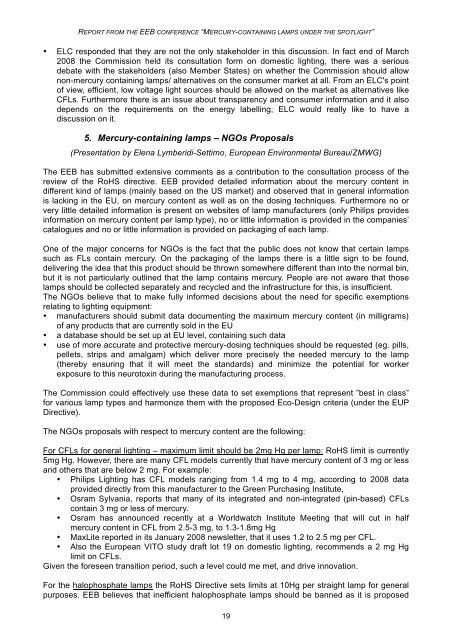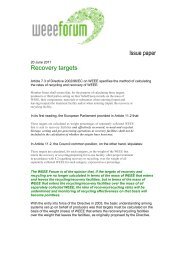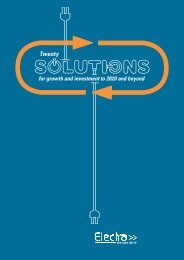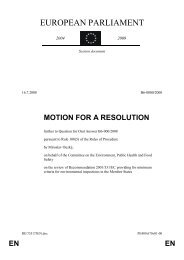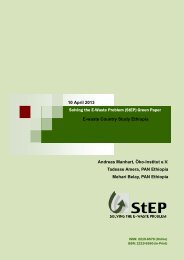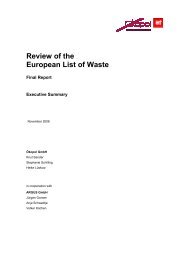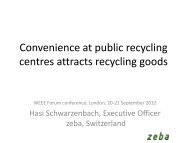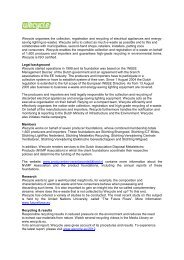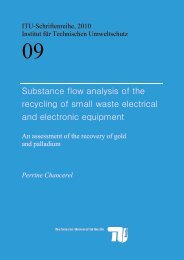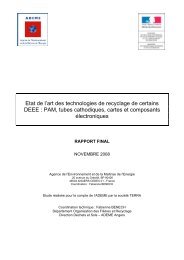Mercury containing lamps under the spotlight - WEEE Forum
Mercury containing lamps under the spotlight - WEEE Forum
Mercury containing lamps under the spotlight - WEEE Forum
You also want an ePaper? Increase the reach of your titles
YUMPU automatically turns print PDFs into web optimized ePapers that Google loves.
REPORT FROM THE EEB CONFERENCE “MERCURY-CONTAINING LAMPS UNDER THE SPOTLIGHT”<br />
• ELC responded that <strong>the</strong>y are not <strong>the</strong> only stakeholder in this discussion. In fact end of March<br />
2008 <strong>the</strong> Commission held its consultation form on domestic lighting, <strong>the</strong>re was a serious<br />
debate with <strong>the</strong> stakeholders (also Member States) on whe<strong>the</strong>r <strong>the</strong> Commission should allow<br />
non-mercury <strong>containing</strong> <strong>lamps</strong>/ alternatives on <strong>the</strong> consumer market at all. From an ELC's point<br />
of view, efficient, low voltage light sources should be allowed on <strong>the</strong> market as alternatives like<br />
CFLs. Fur<strong>the</strong>rmore <strong>the</strong>re is an issue about transparency and consumer information and it also<br />
depends on <strong>the</strong> requirements on <strong>the</strong> energy labelling; ELC would really like to have a<br />
discussion on it.<br />
5. <strong>Mercury</strong>-<strong>containing</strong> <strong>lamps</strong> – NGOs Proposals<br />
(Presentation by Elena Lymberidi-Settimo, European Environmental Bureau/ZMWG)<br />
The EEB has submitted extensive comments as a contribution to <strong>the</strong> consultation process of <strong>the</strong><br />
review of <strong>the</strong> RoHS directive. EEB provided detailed information about <strong>the</strong> mercury content in<br />
different kind of <strong>lamps</strong> (mainly based on <strong>the</strong> US market) and observed that in general information<br />
is lacking in <strong>the</strong> EU, on mercury content as well as on <strong>the</strong> dosing techniques. Fur<strong>the</strong>rmore no or<br />
very little detailed information is present on websites of lamp manufacturers (only Philips provides<br />
information on mercury content per lamp type), no or little information is provided in <strong>the</strong> companies’<br />
catalogues and no or little information is provided on packaging of each lamp.<br />
One of <strong>the</strong> major concerns for NGOs is <strong>the</strong> fact that <strong>the</strong> public does not know that certain <strong>lamps</strong><br />
such as FLs contain mercury. On <strong>the</strong> packaging of <strong>the</strong> <strong>lamps</strong> <strong>the</strong>re is a little sign to be found,<br />
delivering <strong>the</strong> idea that this product should be thrown somewhere different than into <strong>the</strong> normal bin,<br />
but it is not particularly outlined that <strong>the</strong> lamp contains mercury. People are not aware that those<br />
<strong>lamps</strong> should be collected separately and recycled and <strong>the</strong> infrastructure for this, is insufficient.<br />
The NGOs believe that to make fully informed decisions about <strong>the</strong> need for specific exemptions<br />
relating to lighting equipment:<br />
• manufacturers should submit data documenting <strong>the</strong> maximum mercury content (in milligrams)<br />
of any products that are currently sold in <strong>the</strong> EU<br />
• a database should be set up at EU level, <strong>containing</strong> such data<br />
• use of more accurate and protective mercury-dosing techniques should be requested (eg. pills,<br />
pellets, strips and amalgam) which deliver more precisely <strong>the</strong> needed mercury to <strong>the</strong> lamp<br />
(<strong>the</strong>reby ensuring that it will meet <strong>the</strong> standards) and minimize <strong>the</strong> potential for worker<br />
exposure to this neurotoxin during <strong>the</strong> manufacturing process.<br />
The Commission could effectively use <strong>the</strong>se data to set exemptions that represent ”best in class”<br />
for various lamp types and harmonize <strong>the</strong>m with <strong>the</strong> proposed Eco-Design criteria (<strong>under</strong> <strong>the</strong> EUP<br />
Directive).<br />
The NGOs proposals with respect to mercury content are <strong>the</strong> following:<br />
For CFLs for general lighting – maximum limit should be 2mg Hg per lamp: RoHS limit is currently<br />
5mg Hg. However, <strong>the</strong>re are many CFL models currently that have mercury content of 3 mg or less<br />
and o<strong>the</strong>rs that are below 2 mg. For example:<br />
• Philips Lighting has CFL models ranging from 1.4 mg to 4 mg, according to 2008 data<br />
provided directly from this manufacturer to <strong>the</strong> Green Purchasing Institute,<br />
• Osram Sylvania, reports that many of its integrated and non-integrated (pin-based) CFLs<br />
contain 3 mg or less of mercury.<br />
• Osram has announced recently at a Worldwatch Institute Meeting that will cut in half<br />
mercury content in CFL from 2.5-3 mg, to 1.3-1.8mg Hg<br />
• MaxLite reported in its January 2008 newsletter, that it uses 1.2 to 2.5 mg per CFL.<br />
• Also <strong>the</strong> European VITO study draft lot 19 on domestic lighting, recommends a 2 mg Hg<br />
limit on CFLs.<br />
Given <strong>the</strong> foreseen transition period, such a level could me met, and drive innovation.<br />
For <strong>the</strong> halophosphate <strong>lamps</strong> <strong>the</strong> RoHS Directive sets limits at 10Hg per straight lamp for general<br />
purposes. EEB believes that inefficient halophosphate <strong>lamps</strong> should be banned as it is proposed<br />
19


